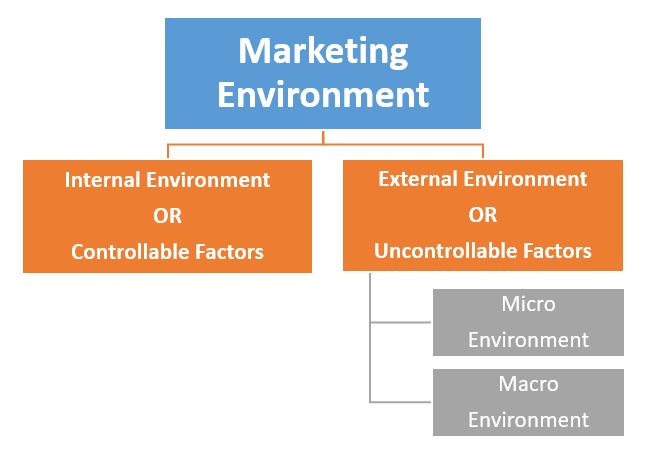The Definitive Guide on Marketing Environment!
Regardless of any field, all businesses are dependent on a certain environment. That environment brings both opportunities, challenges and potential risks to businesses. Hence, Understanding the marketing environment and its importance is the vital step that helps businesses decide on issues related to business activities.
Let learn about this by taking a look at the definitive guide on Marketing Environment below.
What is Marketing Environment?

The marketing environment is a combination of internal and external factors that have a positive or negative effect on the business’s marketing activities.
It is easy to see that any business operates in a particular business environment and is strongly influenced by that environment on its business activities. The changes in the environment profoundly affect on the business, including the good effects and the bad ones. Changes in the environment can be gradual, but can also happen suddenly.
Environmental factors often present business threats, but also bring business opportunities to the business. If the business has enough of that information, they will have plans and measures to overcome the risks and seize favorable opportunities proactively. Therefore, businesses need to understand the environmental factors.
We can divide into two types of environments: Internal Marketing Environment and External Marketing Environment. While the internal environment can be controlled, the business has little or no ability to control the external environment. Go ahead to dive deep into each concept.
Read more:
- What is Price Skimming Strategy?
- What is Display Advertising?
- What is Direct Response Marketing?
- What is Business Level Strategy?
2 Types of Marketing Environment
Internal Marketing Environment

Overview
The internal marketing environment of a business includes all the forces and factors within the organization that directly affect the ability of resources to spend marketing activities and the quality of the company’s marketing decisions. These most critical components can be grouped as follows:
- Business Goals
- Finance
- Human Resources
The internal environment is under the control of the marketer and can be changed as the external environment changes. However, analyzing the internal marketing environment is just as crucial to the business as the analysis of the external marketing environment. This environment includes the sales department, marketing department, manufacturing unit, human resources department, etc.
Marketing decisions depend heavily on the support of the company’s leadership, other management functions, and all employees. Analysis of internal factors will help marketing administrators discover the strengths, weaknesses, capabilities, and resources of the business that can be devoted to marketing activities.
Currently, internal marketing activities to achieve the highest support of all departments and employees in the business are becoming a key condition for effective marketing activities of businesses.
Business Goals
One of the most important factors for marketing or other business activities is your company goals. Remember, however, that company goals are not exactly the same as marketing goals. Your marketing goals are set by you to accomplish your company’s goals.
For example, while your company’s goal is to become the largest producer of soft drinks in the world in the next five years, the only marketing goal might be to promote your soft drink to a large amount of audience and engage them.
You need to prepare and launch campaigns that are good enough to attract more people to your company. Thanks to this, the company can achieve its goal easily.
In simple terms, your marketing campaigns will be influenced by company goals. What’s more, the company goal is completely different from the marketing goal. Marketing goals are simply set to achieve larger business goals.
Finance
For each business, finance always plays a vital and indispensable part. Because finance directly influences on your sales and marketing activities, you can decide what and how to spend based on how much you want.
For example, most small businesses don’t have a formal internal marketing team. Therefore, they often have to contact outside contractors such as web developers, social media professionals, and graphic designers. Besides, they sometimes need to outsource promotional, advertising, and public relations campaigns.
Meanwhile, big companies like Samsung and Sony have huge sums of money. They spend billions of dollars on marketing campaigns and hire some of the best marketing suites in the world.
As a result, smaller companies often find it difficult to compete with the industry giants in terms of spending money. However, they can beat the big bosses by bringing creativity and innovation to their campaigns.
Human Resources
Having an intelligent and efficient workforce is a trump card for any business to succeed. It’s true to say that experience, quality, and efficiency of your workforce are of utmost importance to your marketing campaigns.
A well-trained and dynamic human resource will help you go further than your competition. Just like that, you will be able to create quality products, market effectively, and make customers happy with the services you provide.
Example of Internal Marketing Environment
The office culture of a business is an amazing example of the Internal Marketing Environment. Corporate culture is the values, beliefs, and forms that everyone in the business recognizes and thinks, says, acts like a habit, like the spiritual life and personality of a person, and is decisive to the business’s long-term success or failure.
Corporate culture plays a vital role in the development of every business. If any enterprise lacks cultural elements, it is difficult for that enterprise to stand firm and survive, especially in the current integration period.
Google’s corporate culture is a model of corporate culture. There are many special benefits for their employees, such as free meals, big parties, valuable rewards, executive sharing sessions, even pets allowed, etc.

Currently, Google is increasing the number of employees rapidly. This means that the company’s culture will have to develop more to suit their needs. However, some employees still complain that they are under great pressure due to the competitive environment and the inability to balance work and personal life.
What to learn from the Google corporate culture example: Even companies with the best culture have to constantly revisit themselves and make improvements to accommodate both the size and quality of their teams.
Like other companies, Facebook gives employees many benefits such as stocks, free food, comfortable space, even the laundry area in the office. The culture of focusing on group activities enables people to communicate openly. This is an environment that brings many benefits, supporting staff to improve their qualifications and personal development.

To solve the competition and pressure issues, Facebook has arranged a lot of common offices, many open parks in the aisles. Therefore, employees and leaders always have a place to rest between or gather after work; leaders can also sit and work in open spaces next to other ordinary employees.
What to learn from the Facebook corporate culture example: Spatial layouts are also a way to reinforce and demonstrate a free, equal, and hierarchical work culture.
External Marketing Environment
The external marketing environment is made up of many different factors, while the internal environment can be easily controlled, but the external environment is difficult to do so. The external environment is divided into two different categories: micro and macro marketing environments.
Analyzing and forecasting factors of the external marketing environment helps marketing managers discover opportunities and threats to businesses. Marketing decisions must exploit opportunities and avoid risks.
Read more:
- What is Market Orientation?
- What is Marketing Audit?
- What is Channel Marketing?
- What is Stealth Marketing?
- What is Ambush Marketing?
Micro Environment

Micro-marketing environments are forces that have direct relations with the company itself and its ability to serve customers, that is, suppliers, marketing brokers, customers, competitors, and direct public.
- Enterprise:
Analyzing the business as an agent in the microenvironment, the marketing manager will consider the marketing department’s role in the business, the relationship, and the supporting impact of the production and finance departments. , human resources for the marketing department.
The business’s marketing department is responsible for planning and implementing marketing strategies, plans, policies, and programs through management activities such as marketing research, brand management, and sales administration, etc.
Marketing managers must also coordinate activities with other functional departments such as finance to ensure the budget required for implementing marketing plans, allocating budgets for products, brands, other marketing activities, research, and development department for innovative research or new product design.
It is also necessary to evaluate the marketing capabilities, the strengths and weaknesses of the business’s marketing activities compared with the competitors to choose a competitive marketing strategy and design appropriate marketing policies.
- Supplier:
Suppliers are business organizations or individuals that supply the necessary materials for the production of businesses and competitors.
In order to decide to buy inputs, businesses need to identify them, find their sourcing, quality, and choose the best suppliers in terms of quality, delivery reputation, reliability, and discount guarantee.
Variations in the supply environment can have a significant impact on your business’s marketing. Marketing managers need to keep track of the prices of their primary suppliers. An increase in the price of the supply charge may force the price to increase, reducing the firm’s sales.
Marketing managers need to pay attention to the extent to which suppliers can respond to their business input needs. The scarcity of supply affects business regularity, and therefore the ability of the business to serve customers. Therefore, businesses need to build long-term relationships with major suppliers.
- Marketing brokers:
Marketing brokers are companies that assist a company to grow, sell, and popularize its products among its customers. These include trade brokers, commodity circulation agencies, marketing service organizations, and credit institutions.
Enterprises need to analyze the characteristics and performance of the intermediaries to have appropriate policies to establish and maintain positive relationships, and at the same time, the company may also have the necessary responses to adjust and change product distribution policy to match with changes in the activities of the intermediaries.
- Customer:
Customers are the service objects of the business and are the main drivers of the market. Customers play a very important role because from the needs of customers, new businesses plan their marketing strategies to satisfy customers’ needs and seek profits.
Enterprises need to research their customer’s markets carefully. The business can operate in five types of customer markets:
Consumer market: buying products for personal and home use.
The producer market: includes organizations that purchase goods and services for production to make a profit or fulfill other goals.
Intermediary market: is the organization and individual that buys goods and services to resell for profit.
The market of state agencies: buying goods and services for use in public management and activities or transferring them to other organizations or individuals in need.
International markets: foreign customers include consumers, producers, go-betweens, and governments in other countries.
- Competitors:
In general, every company has to deal with different competitors. Competitors are in many different forms, existing and latent, directly and indirectly. Depending on the level of product substitution, competitors can be divided into four categories: Brand Competition, Industry Competition, Demand Competition, Budget Competition.
- General public:
Any group showing genuine interest or may be interested in the business, affecting the business’s ability to achieve its goals.
Businesses need to prepare marketing plans for the public as well as for the consumer market. Every business typically has the following publics:
Financial public: financial institutions, banks, investors, securities companies, insurance companies affect the ability of enterprises to borrow capital.
Public opinion: Enterprises must instill trust from public opinion organizations, especially newspapers, magazines, radio, and television.
Public government: businesses need to pay attention to the opinions of the authorities when formulating marketing plans such as true advertising, safe production, anti-competition laws.
Social activists: corporate marketing activities can be questioned by consumer organizations, environmental organizations, and other organizations.
Local public: every business must communicate with local communities like local organizations, neighbors.
The general public: businesses need to be mindful of the public’s attitudes toward their activities and products. Although the public does not influence the business as an organized force, the public’s impression of the business will affect its customers.
Internal public: includes the number of employees and intellectuals, managers, and boards. When employees feel comfortable with their business, this positive attitude spreads to the outside of the business.
Macro Environment

Macro-marketing environments are broader social forces that influence the micro-environment, such as demographic, economic, natural, technical, political, and cultural factors.
- Demographic environment:
The first environmental factor that marketing managers need to consider first is population because the population makes up the market. Marketers should pay attention when studying population distribution by geographic area and population density, migration trends, population distribution by age, marital status, birth rate, mortality, race, religious structure.
There are variable trends in the demographic environment that have an especially important impact on the firm, by affecting the number of products demanded and by changing buyer behavior such as structural changes population’s age, changes in family characteristics, changes in population distribution in terms of geography, the structure of population’s education level, etc.
- Economic environment:
The economic environment includes factors that affect the purchasing power of customers and consumption patterns. The market needs buying power as well as buyers. The total purchasing power depends on current income, prices, savings, and credit.
Marketers need to be mindful of the main trends in income changes and consumer consumption dynamics. Changes in key economic variables such as income, the share of income for consumption, the structure of expenditure, savings, or borrowing have a huge impact on the market.
Enterprises with high-value or high-profit products need to study the changing economic environment trends carefully to proactively make adaptive adjustments. In the event of an economic crisis, marketing managers need to take the necessary steps to replace products, reduce costs, and overcome obstacles.
- Natural environment:
The natural environment includes ecological environment, weather, climate, resources, energy. Marketing managers need to consider the opportunities and threats associated with major trends in the transformation of the natural environment: the scarcity of raw materials, increasing levels of pollution, increasing energy costs, strong government intervention in the management of natural resources.
In terms of marketing, the above issues pose many challenges to marketing managers, requiring thinking and finding the right direction for their marketing activities.
- Technology environment:
The technology environment influences marketing management is very diverse, depending on the business’s capabilities. These effects can bring opportunities or pose threats to product innovation and replacement, product life cycle, and the enterprise’s production cost.
Marketers need to understand changes in the technology environment, work closely with research and development experts to encourage more market-driven research, and warn of innovation harms consumers’ legitimate interests.
- Legal and political environment: This environment is created from the legal system, governmental organizations, and influences and binds organizations and individuals’ behavior in society.
When analyzing the political environment, the marketing manager needs to pay attention to the legal system affecting the business increases, the development of groups protecting the community’s interests for political stability. Determination is one of the critical prerequisites for the operation of the business.
- Cultural environment – social:
People grow up in a particular society and it is that society that has cultivated their basic views creating values, and moral standards. The adoption of marketing decisions can be influenced by the following characteristics of cultural lifestyles: staunch loyalty to basic traditional cultural values, cultural branches within a culture, temporary changes of secondary cultural values.
The basic cultural values of society are expressed through the human attitude towards oneself, towards others, to the institutions that exist in society, to the whole society, nature, and value.
Based on the above knowledge, you can conduct micro and macro environment analysis in the marketing of any business.
Example of External Marketing Environment

At the beginning of the 20th century, when CocaCola just started coming to the market. The company used images of celebrities to promote its product lines. Moreover, many times Coca-Cola also boldly spent money on information technology applications. Thereby, the company’s ads are always easy to impress and attract viewers.
Another example that can help us learn a memorable lesson is from Kodak. As we know, Kodak is a major global manufacturer of film cameras. But with the advent of digital cameras that all changed. Kodak himself did not see the potential of these machines. And yet they remain loyal to the film camera. This mistake caused Kodak to lose a huge market share by competitors such as Canon, Fuji, etc.
The most recent is the departure of a king of information technology. Yahoo in the 2000s was the leading chat application in the world. But the advent of smartphones changed everything. Slow in technology transformation, Yahoo has failed to keep its position. Technology companies such as Facebook, Google were born instead.
The Importance of Marketing Environment
For a business, the most important thing is to research and understand the marketing environment. This is essential for the survival of the business.
Refer to the explanation of Remy Lemmens, a Strategic Advisor and Program Manager at Gemeente Goes, on the importance of the marketing environment, AVADA summarizes some of the benefits you can leverage when understanding your marketing environment:
- Identify opportunities:
By grasping your marketing environment, you will identify new opportunities and capture them quickly. Thanks to this, you’ll benefit your business as well as your customers and employees.
For example, if you know that your customers are tending to like your product over your competitors’ products, you can offer discounts to take advantage of this opportunity to sell more products.
- Threats to be identified:
You can identify threats to your business as you analyze your marketing environment. This gives you signs or warnings, helps you stay informed about the threat, and prepare necessary precautions.
Example: Analyzing the marketing environment helps you see that there is a multinational company entering the industry. This will probably affect your business performance. As a result, you can take many ways to combat that threat, such as discounting your products to compete with whatever the company offers or launching a massive promotional campaign.
- Help manage change:
Sudden changes can cause many businesses to fail. Luckily, researching the marketing environment helps you cope with them. Besides, there are changes you can predict and stay one step ahead. In particular, by incorporating some pre-changes, you can put your competitor on the back foot.
Related posts:
- What is International Marketing?
- What is an Internal Analysis?
- What is BANT?
- What is Residual Income?
- What is Green Marketing?
Conclusion
Analyzing the marketing environment helps businesses recognize the strengths, weaknesses, opportunities, and challenges, thereby making the right decisions and strategic marketing directions at the time of analysis. That’s why Marketing Environment is Crucial to Your Business.
This article helps you to understand the concept of the marketing environment and the two types of Marketing Environment. The conceptual understanding and differentiation of different types of marketing environments will help you analyze the environment more effectively and get the most accurate results.
In particular, knowing the importance of the marketing environment will make you more attentive to it and identify potential opportunities and risks that can be easily prevented. I do hope that you will run the company smoothly.
New Posts







